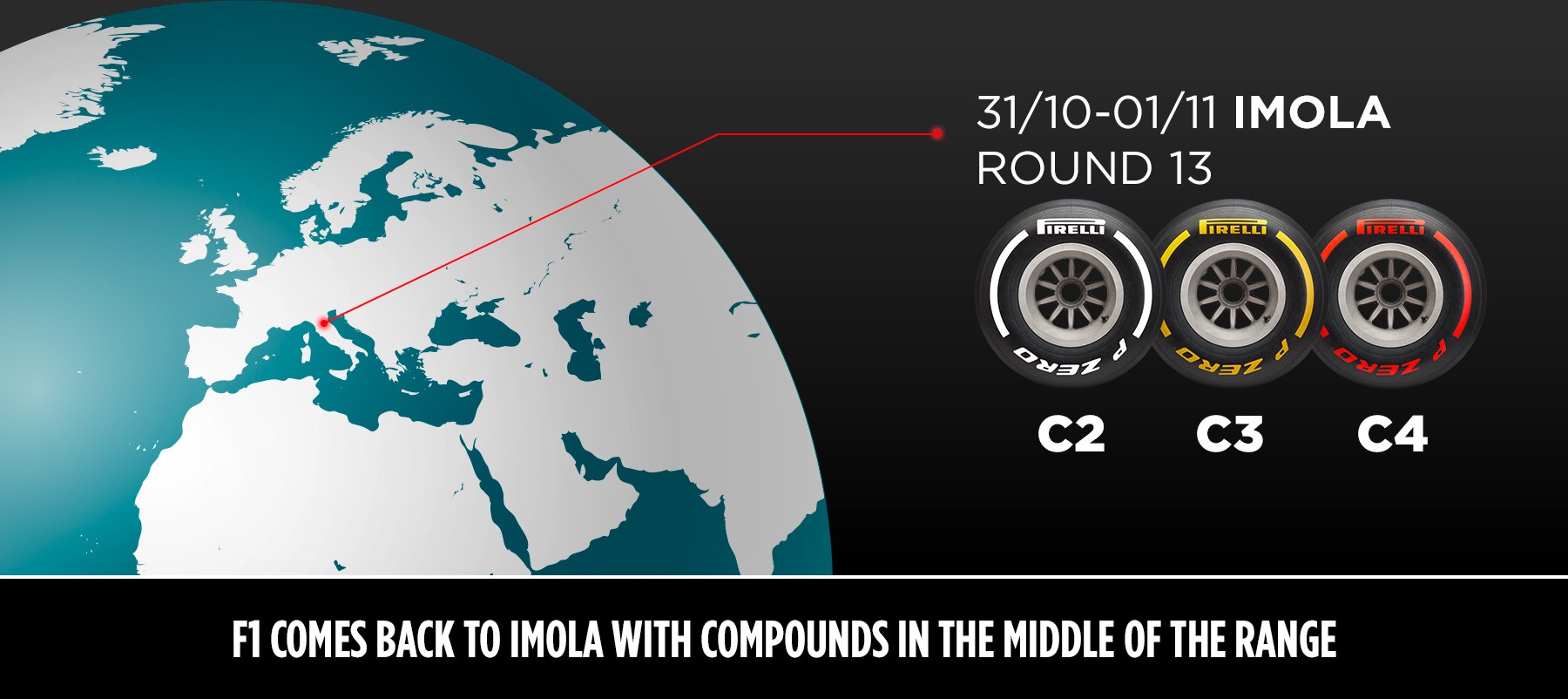2020 Emilia Romagna Grand Prix - Preview
WHY WE’VE CHOSEN THE TYRES
- For the last of an unprecedented three races in Italy this year, Formula 1 returns to Imola for the first time since 2006. The middle three tyres in the range have been chosen: C2 as the P Zero White hard, C3 as the P Zero Yellow medium, and C4 as the P Zero Red soft.
- This race weekend, back-to-back with Portimao, has a very different look to it with no Friday action and just a single 90-minute practice session on Saturday before qualifying. As a result, the tyre quantities have been adjusted. Instead of the usual 13, there will be 10 sets of tyres available to each driver for the whole weekend: two sets of hard, two sets of medium and six sets of soft.
- Drivers will have to give back three sets of tyres after this session, leaving the same number of sets available for qualifying and the race as a standard event. The intermediate and wet tyre allocation remains unaffected.
- The middle tyres in the range have been chosen to suit the characteristics of Imola: a famously technical track with a wide range of different corners that tests every aspect of a car’s performance.
TRACK CHARACTERISTICS
- Like many historic circuits across Europe, Imola was originally created as a road course just after the Second World War, before becoming a permanent circuit that first hosted a (non-championship) Formula 1 race in 1963.
- It has been continuously developed since then, with a number of modifications implemented since Formula 1 last raced there 14 years ago. The old Variante Bassa is gone and the long straight heading into Tamburello is now broken up by two right-hand corners. More run-off areas have been added, especially at Variante Alta, and there are new pit garages too: only the old Marlboro tower remains from the previous start-finish complex.
- Unusually, Imola is an anti-clockwise circuit, with 12 left-hand corners and nine right-hand corners. In contrast to Portimao, the circuit width is quite narrow in places, which makes overtaking reasonably tricky and puts a strong emphasis on race strategy.
- The circuit has been re-asphalted since F1 last race there, meaning that the asphalt is generally quite smooth, and doesn’t put too much stress on the tyres. Because of this, tyres in the middle of the range have been chosen, well-suited to the average demands.
- However, the surface is still quite bumpy and there are some big kerbs, meaning that it’s important to find an adaptable set-up and stick to the racing line. The last Formula 1 team to drive at Imola was AlphaTauri, which used the track for a filming day (plus some testing with an old car) over the summer before the 2020 season re-started in Austria. However, this is the first time that the current generation of turbo hybrid cars will race at Imola.
MARIO ISOLA - HEAD OF F1 AND CAR RACING
“The tests we carried out last weekend in Portimao to assess 2021 tyre specifications went well, as expected. We are now analysing all the data collected, because by November 1st we have to nominate the definitive specification for next year. This weekend at Imola, there’s going to be a lot to get used to in a short space of time. After travelling back from Portugal the teams have to cope with a new race weekend format and reduced practice time on what will be a brand new track for most of the drivers – although inadvertently, they practised this exact scenario at the Nurburgring recently. As you would expect on a circuit with so much history, Imola has an old-school feel to it like Mugello, and we believe that the drivers are going to love racing there. Finding the right set-up as quickly as possible is going to be key to success, as the technical nature of the track means that a number of important compromises have to be made, so it’s always tricky to find the right balance. Overtaking could be quite tricky and the weather at this time of year is unpredictable, so strategy is set to play an important role – but that strategy has to be flexible enough to adapt itself to changing circumstances.”
| MIN. STARTING PRESSURES (slicks) | EOS CAMBER LIMIT | ||
|---|---|---|---|
 |
23.0 psi (front) | 20.0 psi (rear) | -3.50° (front) | -2.00° (rear) |  |
| compounds nominated this season | |||||
|---|---|---|---|---|---|
| Grand Prix | C1 | C2 | C3 | C4 | C5 |
| Austria (July 5) | |||||
| Austria (July 12) | |||||
| Hungary (July 19) | |||||
| Great Britain (August 2) | |||||
| Great Britain (August 9) | |||||
| Spain (August 16) | |||||
| Belgium (August 30) | |||||
| Italy (September 6) | |||||
| Tuscany/Italy (September 13) | |||||
| Russia (September 27) | |||||
| Germany (October 9-11) | |||||
| Portugal (October 23-25) | |||||
| Italy / Emilia Romagna (October 31 – November 1) |
|||||
| Turkey (November 13-15) | |||||
| Bahrain (November 27-29) | |||||
| Bahrain / Sakhir (December 4-6) | |||||
| Abu Dhabi (December 11-13) | |||||
OTHER PIRELLI NEWS
- The Spa 24 Hours, Pirelli’s biggest motorsport event of the year, was won by Nick Tandy, Earl Bamber, and Laurens Vanthoor in a Porsche. The race was interrupted by several red flags, with the majority of the race running in the dark on Pirelli’s wet-weather Cinturato tyres. In total, Pirelli fitted around 12,000 tyres with a team of 65 fitters.
- Pirelli has completed its initial World Rally Championship outdoor testing programme with around 1400 kilometres covered – equivalent to the competitive distance of nearly five WRC rallies.























